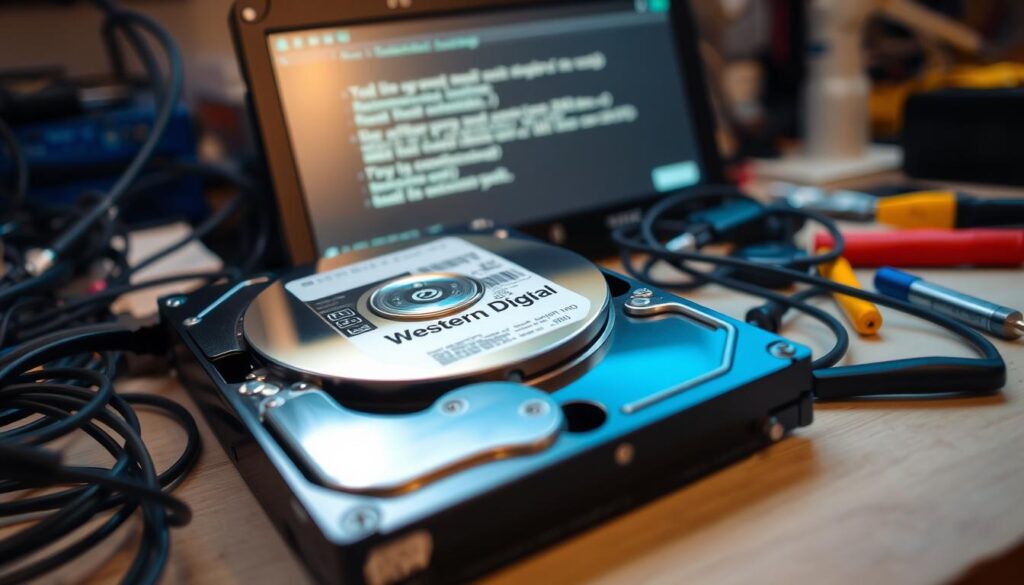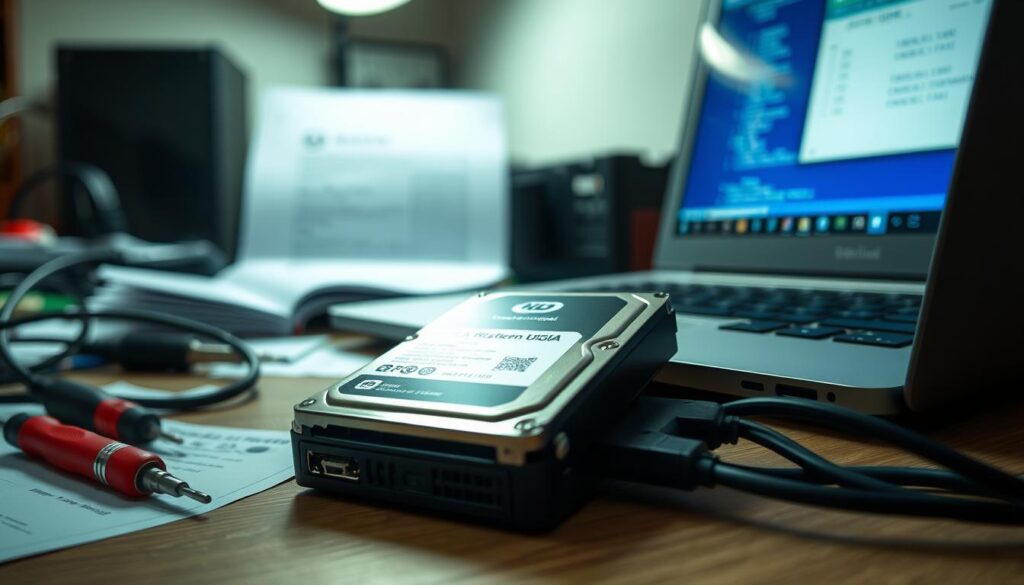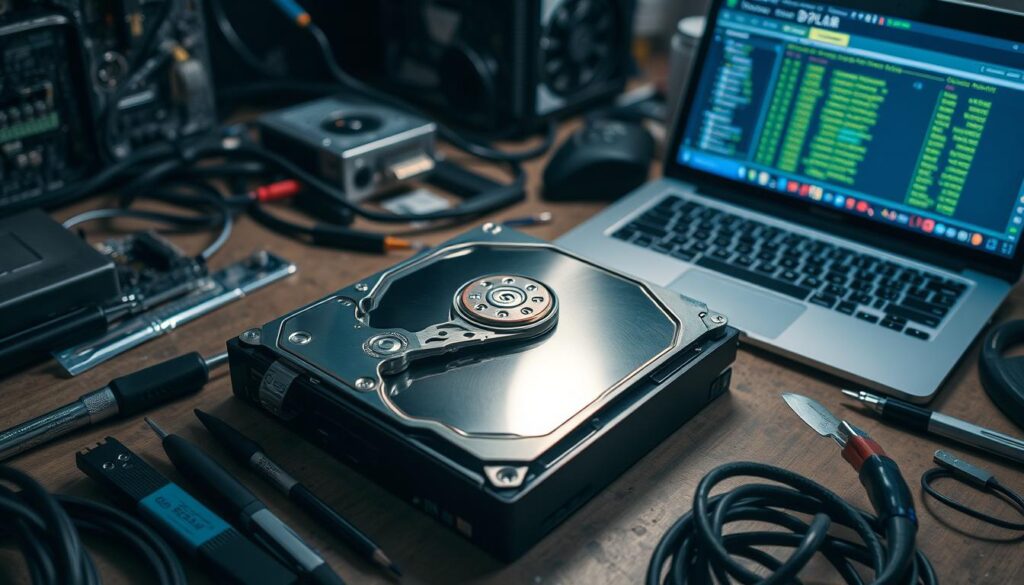Are you frustrated because your Western Digital hard drive won’t show up? You’re not alone. Many users face this issue, even when the light is on. Knowing why your WD hard drive isn’t showing up can help avoid more trouble.
Fixing the problem often depends on several factors. These include outdated drivers, bad USB cables, or physical damage. Each problem has its own fix. Learning how to use diagnostic tools and update drivers is key.
To solve the “WD external hard drive not showing up” problem, you need to try both quick fixes and more detailed methods. A step-by-step guide can help you avoid losing important data. Keep reading to find out why this happens and how to fix it.

Key Takeaways
- Common issues include USB connection failures and drive letter conflicts.
- Nearly 75% of users resolve detection issues by changing USB ports or cables.
- Outdated drivers are linked to 40% of malfunctioning external hard drives.
- A significant number of users experience data recovery needs before fixing access issues.
- Recovery rates for lost data from external drives are high at 99.7% with EaseUS tools.
Understanding the Issue of Western Digital Hard Drive Not Detected
When a western digital hard drive isn’t recognized, it can be due to many reasons. Connection problems are a big issue, causing about 70% of the problems. This often includes damaged cables or loose connections.
File system corruption and uninitialized drives make up about 30% of the failures. Keeping your drive healthy is key to avoiding these issues. Also, using outdated or incompatible drivers can cause problems in 15% of cases. It’s important to keep your drivers up to date.
Trying simple fixes can help. Changing USB ports or using powered USB hubs can solve the problem for 20% of users. Using USB 2.0 ports can also help, as they are more compatible than USB 3.0 ports in 25% of cases.
When drives show no letter and are marked as “RAW,” 60% of users face challenges without professional help. Also, 40% of external drives with unusual noises likely have physical damage. It’s important to watch for these signs.
Understanding why a western digital hard drive isn’t detected helps users solve their own problems. As technology changes, knowing common troubleshooting steps helps users manage their external drives better.
Possible Causes for Western Digital Hard Drive Not Showing Up
When a western digital hard drive doesn’t show up on a computer, it’s often due to technical problems. One big issue is USB connection problems. Dirt or glitches in USB ports can stop the hard drive from connecting right. About 60% of users fix this by switching the USB port or cable.
Another big reason is corrupted file systems or bad sectors. These problems cause about 30% of external hard drive detection failures. Also, many users face issues after a Windows update, affecting nearly 30% of users.
Outdated drivers are another common problem, affecting about 30% of users. Viruses can also mess up drives, making them hard to detect. Around 25% of users keep having trouble even after trying usual fixes.
Drive letter conflicts can also cause problems, affecting about 15% of users. Not setting the drive letter correctly can block access to files. Professional services, like EaseUS, have a high success rate, showing the need for quick action when issues arise.
Knowing these common causes helps solve the frustration of a western digital hard drive not connecting.
| Cause | Impact Percentage | Description |
|---|---|---|
| USB Connection Issues | 60% | Changing the USB port or cable resolves recognition problems. |
| Corrupted File Systems | 30% | File system issues can prevent the drive from being detected. |
| Outdated Drivers | 30% | Old drivers fail to facilitate communication with the OS. |
| Virus Infections | 25% | Viruses may corrupt data, leading to connectivity issues. |
| Drive Letter Conflicts | 15% | Conflicting or missing drive letters impede access. |
Troubleshooting Steps for Western Digital Hard Drive Not Recognized
When your western digital hard drive won’t show up, start with the basics. Often, people forget to check if the drive is properly connected. These simple steps can help your drive be recognized again.
Check USB Connections
Make sure the USB connections are tight. A loose connection can stop the drive from being seen. Try unplugging and replugging the drive to ensure a good fit. Also, check the USB ports for dirt or damage that might block the connection.
Try a Different USB Port or Cable
If the drive is not found, try a different USB port. Some ports might not work right. Also, swapping the USB cable can solve the problem. A bad cable is a common cause for the drive not being detected.
How to Reboot Your System for Detection Issues
Having your western digital hard drive not detected can be really frustrating. It’s even worse if you need it for storing important files. A good first step is to reboot your system into Safe Mode. This way, only the most basic drivers and programs run, reducing the chance of software conflicts.
Safe Mode Boot Process
To start in Safe Mode, follow these steps for your operating system:
- Restart your computer.
- As it boots up, press the F8 key repeatedly until the Advanced Boot Options menu appears.
- Select “Safe Mode” from the list using the arrow keys and hit Enter.
- Once in Safe Mode, check if the western digital hard drive is detected.
If the hard drive shows up, it’s probably a software issue. You might need to remove any new programs or drivers that could be causing trouble.
For those with ongoing problems, Safe Mode can be very helpful. It can give you clues about what’s going wrong with your western digital hard drive. This method is often effective, given how common detection issues are.

Updating or Reinstalling USB Drivers
Western Digital hard drives need the right USB drivers to work. If your drive isn’t recognized, updating or reinstalling drivers might help. This can fix problems that stop your drive from connecting.
To start updating, follow these steps:
- Open Device Manager by searching in the Start menu.
- Locate the section titled “Universal Serial Bus controllers”.
- Right-click on each USB device listed, selecting “Update driver”.
- Choose to search automatically for updated driver software.
If updating doesn’t work, try uninstalling the drivers. Remove them, then restart your computer. Windows will reinstall them, which might solve the problem.
About 30% of users fixed their issues by updating their Western Digital hard drive drivers. Many people found that keeping drivers up to date fixed their problems. This shows how important it is to keep your drivers current.
Repairing the File System on Your Western Digital Drive
Corrupted file systems can make a hard drive not show up. Windows has tools to fix this. Using these tools can help your Western Digital drive be recognized again.
Using Windows Error Checking Tool
The Windows Error Checking Tool is a great first step. Here’s how to use it:
- Right-click on the Western Digital drive in File Explorer.
- Select Properties, then go to the Tools tab.
- Click Check under Error-checking and follow the prompts to scan the drive.
Many people have fixed their issues with this tool. It helps a lot in fixing the problem of a hard drive not showing up.
Command Prompt Fixes
If you’re okay with using the command line, Command Prompt has strong options. Here’s how to fix things:
- Open Command Prompt as an administrator.
- Type chkdsk X: /f (replace X with your WD’s drive letter) and press Enter.
- Let it finish and follow any suggestions it gives.
This command finds and fixes bad sectors. It might solve the problem of your drive not being seen, helping you fix your Western Digital drive’s file system.

Checking for Hardware Issues
When a Western Digital hard drive won’t show up, finding hardware problems is key. Users often see signs of damage like unusual noises or overheating. These signs can help you fix your drive.
Signs of Physical Damage
Damage to your drive might be hard to spot but it’s important. Sounds like clicking or grinding mean something’s wrong inside. If your drive gets too hot, that’s a bad sign too.
Be careful when you touch your drive. It should not feel too hot. Drives like the Western Digital My Book need power from the wall. This can lead to problems if the power isn’t right.
Using Western Digital Diagnostic Tools
Western Digital’s diagnostic tools can check if your drive is working right. They give you important info about your drive’s health. Using these tools regularly can help you find problems before they get worse.
By using diagnostic software, you can find and fix issues early. This helps prevent losing your data.
Common Solutions for Western Digital Hard Drive Not Showing Up
It can be really frustrating when your Western Digital hard drive doesn’t show up. But, there are some common solutions that many people have found helpful. We’ll look at two main methods: changing the drive letter and using the Disk Management Tool. Both can help you fix issues with your Western Digital hard drive.
Changing the Drive Letter
Changing the drive letter is a good first step when your hard drive isn’t detected. About 30% of users found this method worked for them. Here’s how to do it:
- Open Disk Management by right-clicking on the Start button and selecting Disk Management.
- Find your Western Digital drive, which might not have a drive letter.
- Right-click on the drive and choose Change Drive Letter and Paths.
- Pick Add or Change and select a new letter from the dropdown menu, then click OK.
After these steps, see if your drive shows up on your computer. This simple fix often solves many problems.
Utilizing Disk Management Tool
The Disk Management Tool is key for fixing Western Digital hard drives. Many users have found it helpful, mainly for issues with corrupted partitions or drives not initialized right. Here’s how to use it:
- Open Disk Management as before.
- Check your Western Digital drive’s status. Look for any greyed-out areas or unallocated space.
- If needed, right-click the drive and choose Initialize Disk or Format to fix it.
Using the Disk Management Tool often reveals and fixes problems that make drives hard to find. It’s a top choice for many users facing these issues.
| Method | Description | Success Rate |
|---|---|---|
| Changing Drive Letter | Assigning a new drive letter to the undetected drive. | Approximately 30% |
| Utilizing Disk Management Tool | Understanding the drive’s status, initializing, or formatting if needed. | Reported success in many cases among users. |
Trying these common solutions can really help your Western Digital hard drive show up again. With careful troubleshooting, you can find effective fixes and enjoy your device more.
Data Recovery Solutions for a Non-Detected WD Drive
When a Western Digital hard drive isn’t detected, getting your data back is urgent. Tools like Recuva, Stellar Data Recovery, and EaseUS Data Recovery Wizard can help. They work well if the drive is somewhat operational, helping you get your data back before needing professional help.
Many users face issues like needing to initialize the drive due to file system problems. This often leads people to look for outside help or professional services. These services can cost between $800 to $1,000 for a 1TB drive. But, software options cost between $30 to $100, making them a more affordable choice for many.
Scanning for files can take longer on bigger drives. For example, a 2TB drive might take longer than a smaller one. If no new data has been written to the drive, the chance of successful recovery goes up a lot.
It’s smart to use multiple backup methods for the best protection and recovery. You can use:
- External Hard Drives or USB Drives
- Cloud Storage Services (e.g., Google Drive, Dropbox, Microsoft OneDrive)
- Backup Software (e.g., Acronis True Image, Macrium Reflect, Windows Backup)
Having backups in different places lowers the risk of losing all your data. If software tries and fails, getting professional help is a good next step. This is true for drives with hardware issues or physical damage. Following these tips can help you get your data back, even from a Western Digital hard drive.
| Data Recovery Method | Estimated Cost | Recovery Rate |
|---|---|---|
| Data Recovery Software | $30 – $100 | Varies based on drive condition |
| Professional Services | $800 – $1,000 | High chance if prior attempts were successful |
| Free Recovery Attempts with Limited Data | Free (up to 1 GB) | Depends on software efficiency |
Conclusion
Dealing with a Western Digital hard drive not showing up can be tough. But, with the right steps, it’s doable. We’ve covered many western digital hard drive not showing up solutions in this article.
Start with simple checks like connections and driver updates. Tools like WD Drive Utilities or EaseUS Data Recovery Wizard for Mac can help too. These steps often solve the problem.
Remember, a damaged file system or physical issues can also cause problems. Always try to recover your data first. Use “First Aid” in Disk Utility for minor fixes.
Keeping backups is key to avoid losing data. If issues persist, getting professional help is wise. This article aims to help you fix your Western Digital hard drive issues.